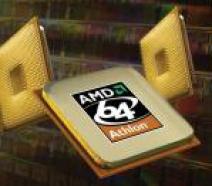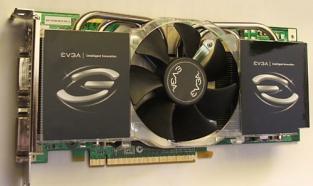OOPS! You forgot to upload swfobject.js ! You must upload this file for your form to work.
INTEL PENTIUM 4 (NORTHWOOD) 2.0AGHZ AND 2.2GHZ AGAINST AMD ATHLON XP 2000+
![]()
|
|
 |
||||||||||||
| Posted:2002-05-20 By Asboulougia Number of View:8922 |
|||||||||||||
By :Asboulougia Posted:2002-05-20
Today Intel and AMD are expected to launch their new high-performance processors. Intel is supposed to announcetwo new CPUs based on the 0.13micron Northwood core and featuring larger 512KB L2 cache, while AMD should announceits Athlon XP 2000+ working at 1.67GHz. We couldn\'t leave out such an important event. So, if you are following thecompetition between the two leading CPU developers, then you simply can\'t miss our review! Table of contents: Intel Pentium 4 (Northwood) AMD Athlon XP 2000+ Testbed and Methods Performance Office and Content Creation Applications Pentium 4 Processor Application Launcher v.2.1 3D Games Scientific and Professional OpenGL Applications Conclusion It is over a year already that we are watching a really exciting battle between the Intel Pentium 4 and AMD Athlon families for the right to be called the fastest desktop solutions. Both, AMD and Intel, which have been pushing their architectures into the market, for a long time couldn\'t offer any indisputably best solution to beat the competitor from all viewpoints. Since the launching of the first Pentium 4 processors, there has been no leader in the competition between it and Athlon: the core clock frequencies grew higher and the leadership migrated from one to another all the time. Neither great computing capacity of the Athlon processor, nor NetBurst architecture of the Pentium 4, which allowed it to work at incredibly high core clock frequencies, could grant indisputable advantage to one of the competing CPU families This situation has slightly changed in the middle of autumn, when the renewed Athlon XP family came out. These CPUs based on the new 0.18micron Palomino core boasted some minor architectural improvements, such as the implementation of SSE instructions support, TBL enlargement and introduction of Data Prefetch Logic, however, they started dashing ahead of the eldest Pentium 4 processors. Moreover, the core frequency of the Athlon XP processors grew much faster during the last couple of months than that of the Pentium 4 CPU family, which froze at 2GHz. As a result, in the end of 2001 Athlon 1900+ won all the laurels of the fastest desktop CPU. However, Intel was preparing a worthy response to AMD\'s launching of the Athlon XP family. This response was a new 0.13micron Northwood core, which from now on will be used in the latest Pentium 4 processors. AMD in its turn also didn\'t keep its hands in pockets and reacted to the announcement of the new Pentium 4 (Northwood) working at 2.2GHz with the launching of the next Athlon XP 2000+ processor working at 1.67GHz. So, today we will dwell on these two latest solutions from the Pentium 4 and Athlon XP families. To begin with, let\'s take a closer look at our today\'s heroes. Intel Pentium 4 (Northwood) New Northwood core to be used in the upcoming Pentium 4 processors doesn\'t differ too much from the predecessor from the architectural point of view. if you are looking for more details on the architecture peculiarities of the Willamette core. But what forced Intel to develop a new core? The reasons are quite standard, actually. 2GHz frequency appeared a kind of top for the 0.18micron manufacturing technology, which is used for Pentium 4 (Willamette) production. Therefore, Intel had to resort to more progressive manufacturing methods in order to be able to continue this CPU family. Here we should note that the seeming low heat dissipation of Pentium 4 processors on Willamette core is a pretty illusory thing. Although the coolers used with Pentium 4 processors, even with those working at 2GHz remain not that hot doesn\'t mean anything, in fact. The matter is that Pentium 4 core heats not very evenly, so that some parts of it dissipate much more heat the other parts. Therefore, it appeared completely impossible to continue increasing the clock frequency of Willamette, even though the general temperature wasn\'t that high. As usual, a more advanced manufacturing technology helps to solve this problem. In the middle of last year already Intel had at its disposal some production lines for 0.13micron processors. In particular, Intel used this technology to produce Pentium III processors based on Tualatin core. At first, they were going to introduce finer manufacturing process for Pentium 4 CPUs in autumn. However, the company had some problems with purchasing the necessary equipment, so that the first 0.13micon Pentium 4 CPUs came out only now. Well, let\'s try to figure out what the differences between the new 0.13micron Pentium 4 (Northwood) and 0.18micron Pentium 4 (Willamette) are. First of all, we would like to point out that the cores manufactured with the new finer technology are smaller in size. So, Intel got the chance to add some more transistors implementing larger L2 cache. This way, the new Northwood acquired a twice as large 512KB L2 cache (unlike 256KB by Willamette). But even despite it, the size of Northwood die remained smaller than Willamette: only 145sq.mm by Northwood against 214sq.mm by Willamette. Besides, the use 0.13micron technology allowed reducing the Vcore of Pentium 4 (Northwood) from 1.75V to 1.5V, which certainly influenced the heat dissipation. If the maximum heat dissipation of the older Pentium 4 processors working at 2GHz made 69W, then the new Pentium 4 Northwood working at the same clock frequency dissipate only 41W of heat. The first processors on the new Northwood core will work at 2Ghz and 2.2GHz core clock. In order to distinguish between Pentium 4 (Northwood) 2GHz and Pentium 4 (Willamette) 2GHz, Intel decided to call its newly born baby Pentium 4 2AGHz. Note that later on Intel is planning to use the new processor core not only for its fastest CPU models, but will move it little by little into the processors working at the frequencies below 2GHz. In the beginning of April there will arrive two more Pentium 4 (Northwood) processors: 2.26Ghz and 2.4GHz. They will be using a new 133MHz FSB, i.e. Intel will start implementing a new Quad Pumped Bus working at 533MH instead of the today\'s 400MHz bus. In order to prove that the new Northwood core doesn\'t have any other architectural improvements besides the increased L2 cache telling on the processor performance, we decided to run some synthetic benchmarks. We measured the performance of Pentium 4 2GHz on Willamette core and Pentium4 2GHz and 2.2GHz on Northwood core. For our tests we selected some benchmarks from SiSoft Sandra 2001 set. The algorithms used in this package to test different parts of the CPU are so simple that the results depend neither on the memory subsystem, nor on the processor cache size. 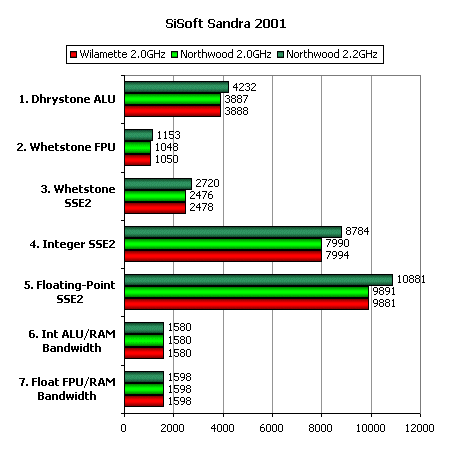 As you can notice, the performance rates of the CPUs built on different cores and working at the same core clock coincide. It means that Northwood doesn\'t have any improved calculating units compared with Willamette. As for the larger L2 cache, its advantages can be traced with the help of a benchmark measuring the memory subsystem performance, namely with cachemem test: 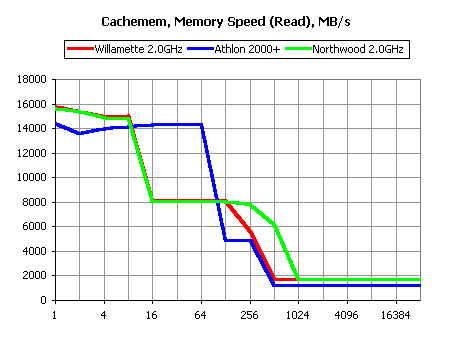 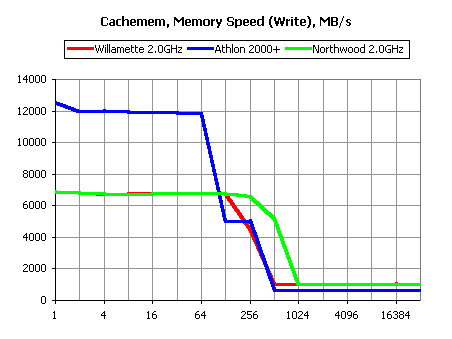 Both graphs, for the read and write speed, show clearly that the L2 cache of Northwood processor increased up to 512KB. Besides that, no other changes touched the memory subsystem performance. If you look at the first graph, for instance, you will be able to see that the part of the L1 cache intended for data remained unchanged and equals 8KB. Although we used to say that it is exactly the small L1 cache that limits the performance Pentium 4 CPU in many cases. For example, their competitors, Athlon XP processors, have 64KB L1 cache for data, which is 8 times bigger. AMD Athlon XP 2000+ Although the story about new Intel processors appeared pretty long, we won\'t be able to say so much about the new AMD Athlon XP. New Athlon XP with 2000+ rating is built on the same architecture as its predecessors, i.e. on the 0.18micron Palomino core, which we have already discussed in great detail. That is why if you want to learn more about 0.18micron Palomino and about the performance rating introduced by AMD, please, see our AMD Athlon XP Processor Family Review. Here we will point out just the basic features of Athlon XP 2000+ differing it from the predecessors. In the first place, it is the increased core clock frequency. Athlon XP 2000+ works at 1.67GHz and with the 133MHz FSB uses 12.5x multiplier, which is the maximum possible multiplier today. This processor dissipates the 70W of heat (at the most). Athlon XP 2000+ is the last CPU of the Athlon XP family based on 0.18micron Palomino core. The next processor of this family due in the end of Q1 2002 will acquire a new Thoroughbred core produced with 0.13micron technology. However, as is known so far, Thoroughbred will not differ architecturally from the predecessor that is why we don\'t expect the processor performance to grow for the reasons other than the frequency growth. The interesting thing is that the new Athlon XP 2000+ looks just the same as the previous slower models. Even though some Athlon XP 1900+ processors were built on the green processor board, the sample of Athlon XP 2000+, which we had at hand, was painted in usual brown color. Testbed and Methods As we have already told you before, our today\'s test are devoted to the performance of the latest processor models of the year 2002 from the Pentium 4 and Athlon XP families. At the same time we paid attention to the advantages of the new Northwood core of Pentium 4 CPUs and tried to compare it with the good old Willamette, which has been used in Pentium 4 processors all this time. That is why we tested two new Intel Pentium 4 processors on Northwood core working at 2Ghz and 2.2GHz, Pentium 4 2GHz based on the Willamette core and two AMD Athlon XP CPUs: 1900+ and 2000+ working at 1.6GHz and 1.67GHz correspondingly. To test our processors we assembled the most popular and high-performance platforms. Pentium 4 processors were tested with an i850 based mainboard and RDRAM, while for Athlon XP CPUs we took VIA KT266A based mainboard with DDR SDRAM. The table below shows the details of the testbed configurations: 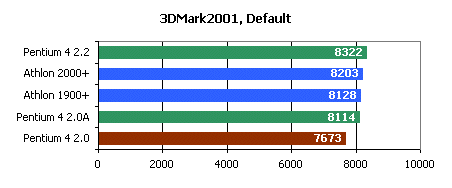 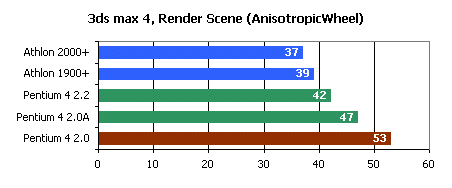 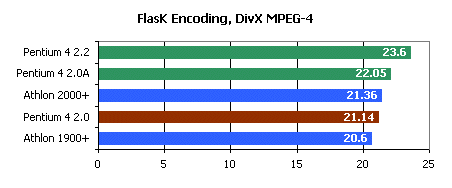 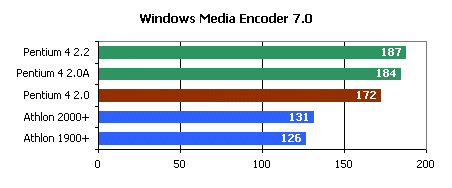 In all the benchmarks Pentium 4 processors built on Northwood core appeared faster than their competitors from AMD. To tell the truth, this is very sad news for AMD, bearing in mind that Athlon XP used to be the leader in DRV-07 and DX-06 tests before Northwood announcement. However, larger L2 cache and higher clock frequencies of the new Pentium 4 CPUs did a great job having made Athlon XP not so attractive for professional OpenGL applications. Conclusion If we try to remember, what the first Pentium 4 was supposed to be like before the actual launching, then we will definitely arrive at the conclusion that Willamette turned out quite far from what Intel expected to get. Technological problems made Santa Clara engineers cut down some features of the NetBurst architecture. They deleted L3 cache and a bit of L1 cache intended for storing data. Moreover, they have also imposed some restrictions on the FPU/SSE2 unit. So, Pentium 4 appeared not so fast as Intel had initially planned to make it. Therefore, it is quite logical that competing solutions from AMD, Athlon XP processors, very often showed better performance than Pentium 4. Now that the new Northwood core came, the situation began changing little by little. We have already complained about the too small cache of Pentium 4 CPUs that is why the increase in L2 cache memory from 256KB to 512KB resulted into a significant performance boost: from 5% to 15%. Besides, the migration to 0.13micron manufacturing technology will allow to keep raising the core clock frequency. So, the latest Pentium 4 processors built on the new core will be not only worthy competitors to Athlon XP, but will also prove much faster than the rivals. Keeping in mind that AMD also doesn\'t waste its time, working on faster Athlon XP processors, the situation can be described as follows. In those apps, which use SSE2 instructions set or work with large packs of streaming data (for example, some games, MPEG-2 encoding, content creation applications and some professional tasks), elder Pentium 4 CPUs win the first prize
we would be happy to answer for your question . if you have suggestion or comment
regarding this review our support would be glad to help just join our forum and ask u will get the best answer
to discuss check our forum section :-) RATE THIS REVIEW | |||||||||||||
![]()

Intel Pentium 4 (Northwood) 2.0AGHz and 2.2GHz against AMD Athlon XP 2000+
Intel Pentium 4 (Northwood) 2.0AGHz and 2.2GHz against AMD Athlon XP 2000+


7600gt review
7600gt is the middle card range.
We already benchmarked this video card and found that ...

 geforce 8800gtx and 8800gts
geforce 8800gtx and 8800gts  Xtreview software download Section
Xtreview software download Section  AMD TURION 64 X2 REVIEW
AMD TURION 64 X2 REVIEW  INTEL PENTIUM D 920 , INTEL PENTIUM D 930
INTEL PENTIUM D 920 , INTEL PENTIUM D 930  6800XT REVIEW
6800XT REVIEW  computer hardware REVIEW
computer hardware REVIEW  INTEL CONROE CORE DUO 2 REVIEW VS AMD AM2
INTEL CONROE CORE DUO 2 REVIEW VS AMD AM2  INTEL PENTIUM D 805 INTEL D805
INTEL PENTIUM D 805 INTEL D805  Free desktop wallpaper
Free desktop wallpaper  online fighting game
online fighting game  Xtreview price comparison center
Xtreview price comparison center Lastest 15 Reviews


Last News
- The new version of GPU-Z finally kills the belief in the miracle of Vega transformation
- The motherboard manufacturer confirms the characteristics of the processors Coffee Lake
- We are looking for copper coolers on NVIDIA Volta computing accelerators
- Unofficially about Intels plans to release 300-series chipset
- The Japanese representation of AMD offered monetary compensation to the first buyers of Ryzen Threadripper
- This year will not be released more than 45 million motherboards
- TSMC denies the presentation of charges from the antimonopoly authorities
- Radeon RX Vega 64 at frequencies 1802-1000 MHz updated the record GPUPI 1B
- AMD itself would like to believe that mobile processors Ryzen have already been released
- AMD Vega 20 will find application in accelerating computations
- Pre-orders for new iPhone start next week
- Radeon RX Vega 57, 58 and 59: the wonders of transformation
- ASML starts commercial delivery of EUV-scanners
- The older Skylake processors with a free multiplier are removed from production
- Meizu will release Android-smartphone based on Helio P40
- AMD Bristol Ridge processors are also available in American retail
- The fate of Toshiba Memory can be solved to the next environment
- duo GeForce GTX 1080 Ti in GPUPI 1B at frequencies of 2480-10320 MHz
- New Kentsfield overclocking record up to 5204 MHz
- Lenovo released Android-smartphone K8

HALO 3 HALO 3 - Final Fight!

PREY Prey is something you don t often see anymore: a totally unigue shooter experience.

computer news computer parts review Old Forum Downloads New Forum Login Join Articles terms Hardware blog Sitemap Get Freebies
